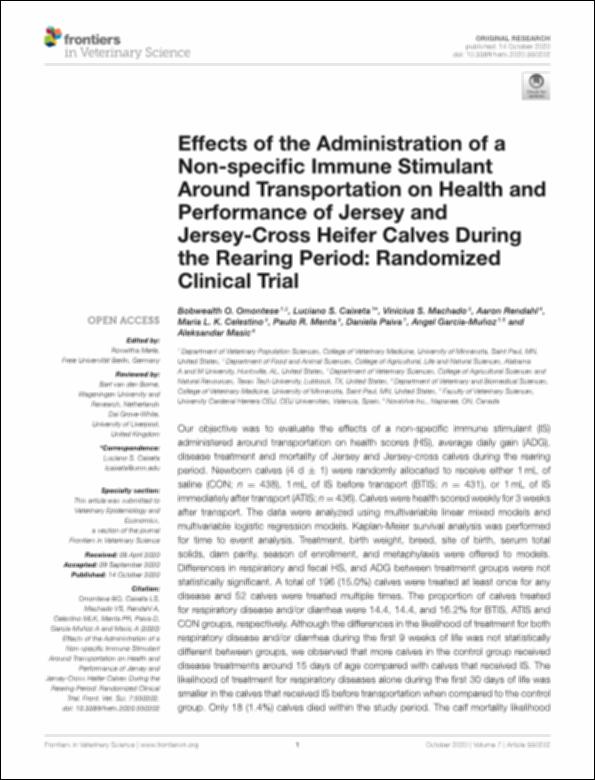Please use this identifier to cite or link to this item:
http://hdl.handle.net/10637/12676Effects of the administration of a non-specific immune stimulant around transportation on health and performance of Jersey and Jersey-Cross heifer calves during the rearing period : randomized clinical trial
| Title: | Effects of the administration of a non-specific immune stimulant around transportation on health and performance of Jersey and Jersey-Cross heifer calves during the rearing period : randomized clinical trial |
| Authors : | Omontese, Bobwealth O. Caixeta, Luciano S. Machado, Vinicius S. Rendahl, Aaron Celestino, Maria L. K. Menta, Paulo R. García Muñoz, Ángel |
| Keywords: | Ganado vacuno - Razas - Jersey - Enfermedades - Tratamiento.; Immunological adjuvants.; Adyuvantes inmunológicos.; Cattle breeds - Jersey - Diseases - Treatment. |
| Publisher: | Frontiers Media. |
| Citation: | Omontese, B.O., Caixeta, L.S., Machado, V.S., Rendahl, A., Celestino, M.L.K., Menta, P.R. et al. (2020). Effects of the administration of a non-specific immune stimulant around transportation on health and performance of Jersey and Jersey-cross heifer calves during the rearing period: randomized clinical trial. Frontiers in Veterinary Science, vol. 7, art. 550202 (14 oct.). DOI: https://doi.org/10.3389/fvets.2020.550202 |
| Abstract: | Our objective was to evaluate the effects of a non-specific immune stimulant (IS) administered around transportation on health scores (HS), average daily gain (ADG), disease treatment and mortality of Jersey and Jersey-cross calves during the rearing period. Newborn calves (4 d ± 1) were randomly allocated to receive either 1mL of saline (CON; n = 438), 1mL of IS before transport (BTIS; n = 431), or 1mL of IS immediately after transport (ATIS; n=436). Calves were health scored weekly for 3 weeks after transport. The data were analyzed using multivariable linear mixed models and multivariable logistic regression models. Kaplan-Meier survival analysis was performed for time to event analysis. Treatment, birth weight, breed, site of birth, serum total solids, dam parity, season of enrollment, and metaphylaxis were offered to models. Differences in respiratory and fecal HS, and ADG between treatment groups were not statistically significant. A total of 196 (15.0%) calves were treated at least once for any disease and 52 calves were treated multiple times. The proportion of calves treated for respiratory disease and/or diarrhea were 14.4, 14.4, and 16.2% for BTIS, ATIS and CON groups, respectively. Although the differences in the likelihood of treatment for both respiratory disease and/or diarrhea during the first 9 weeks of life was not statistically different between groups, we observed that more calves in the control group received disease treatments around 15 days of age compared with calves that received IS. The likelihood of treatment for respiratory diseases alone during the first 30 days of life was smaller in the calves that received IS before transportation when compared to the control group. Only 18 (1.4%) calves died within the study period. The calf mortality likelihood was not statistically different between study groups; however, fewer calves in the IS groups died when compared to CON. In conclusion, the use of IS around transportation did not influence weekly HS, ADG, and the number of disease treatments during the rearing period, but administering IS before transportation resulted in fewer treatments of respiratory diseases during the first 30 days post-transport and marginally lower mortality rates during the rearing period. |
| Description: | Este artículo se encuentra disponible en la siguiente URL: https://www.frontiersin.org/articles/10.3389/fvets.2020.550202/full En este artículo también participan: Daniela Paiva y Aleksandar Masic. |
| URI: | http://hdl.handle.net/10637/12676 |
| Rights : | http://creativecommons.org/licenses/by/4.0/deed.es |
| ISSN: | 2297-1769 (Electrónico). |
| Issue Date: | 14-Oct-2020 |
| Center : | Universidad Cardenal Herrera-CEU |
| Appears in Collections: | Dpto. Producción y Sanidad Animal, Salud Pública Veterinaria y Ciencia y Tecnología de los Alimentos |
Items in DSpace are protected by copyright, with all rights reserved, unless otherwise indicated.


